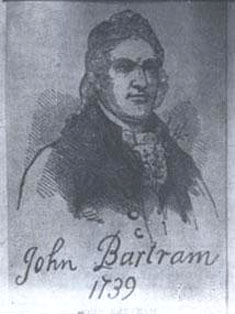| John Bartram  Born: 23-Mar-1699 Born: 23-Mar-1699
Birthplace: Darby, PA
Died: 22-Sep-1777
Location of death: Philadelphia, PA
Cause of death: unspecified
Remains: Buried, Darby Friends Cemetery, Darby, PA
Gender: Male
Religion: Quaker
Race or Ethnicity: White
Sexual orientation: Straight
Occupation: Naturalist Nationality: United States
Executive summary: Colonial botanist to King George III Colonial American botanist John Bartram was raised in a successful farming family, and developed a strong interest in agriculture as a child. In his adolescence he purchased books to learn about plants, and in his late 20s he purchased 107 acres near Philadelphia, where he built a stone house and established a botanical garden still tended and toured today. His expeditions collecting and cataloguing plant life in the Blue Ridge Mountains (1738), the Lake Ontario region (1751), the Catskills (1755), and the Carolinas (1760) brought him some contemporary respect, and in 1765 he was named Botanist to King George III.
He was a key supplier of seeds from the New World to Europe, a trade facilitated through decades of mailed packages and correspondence with English merchant Peter Collinson (1694-1768). His work as seed supplier led numerous members of European royalty to support Bartram with "subscriptions" -- financial support in exchange for seeds, bulbs, and cuttings. Among the plant species popularized through this work were Kalmias, Rhododendrons, and Magnolias. He was the first American to hybridize plants, and visitors to his home included George Washington and Thomas Jefferson. He was described by Carolus Linnaeus as "the greatest natural botanist in the world", while noted naturalist Cadwallader Colden was of a contrary opinion, and saw Bartram as merely a collector, not a true scientist, because Bartram eschewed systematic cataloguing of botanical information.
As a young man he owned several slaves, but he later had a radical change of heart, freeing his slaves and becoming an outspoken abolitionist. In 1758 Bartram was formally expelled from his Quaker congregation after he refused to claim the divinity of Jesus Christ, but despite the church action Bartram continued attending Quaker services. His son, William Bartram, became a noted naturalist in his own right, and together the two Bartrams discovered the Franklinia flower, named for their friend Benjamin Franklin. The elder Bartram was a founding member of Franklin's American Philosophical Society. His descendants include suffragette and labor activist Florence Kelley.
Father: William Bartram (d. 22-Sep-1711 Indian attack)
Mother: Eliza Hunt Bartram (m. 24-Mar-1696, d. 21-Aug-1701 childbirth)
Brother: James Bartram (b. 6-Aug-1701)
Mother: Elizabeth Smith Bartram (stepmother, m. William Bartram 1707)
Sister: Elizabeth Bartram (stepsister, b. 30-Dec-1709)
Brother: William Bartram (stepbrother, b. 3-Apr-1711)
Father: John Smith (stepfather, m. Elizabeth Smith Bartram 15-Sep-1715)
Wife: Mary Maris (or Morris) Bartram (b. 1703, m. 1723, d. Apr-1727, two sons)
Son: Richard Bartram (b. 24-May-1724, d. 19-Nov-1727)
Son: Isaac Bartram (chemist, b. 17-Sep-1725, d. Jun-1801)
Wife: Ann Mendenhall Bartram (b. 22-Sep-1703, m. 11-Oct-1727, d. 29-Jan-1789, five sons, four daughters)
Son: James Bartram (farmer, b. 25-Jun-1730, d. 6-Jan-1824)
Son: Moses Bartram (b. 16-Jun-1732)
Daughter: Elizabeth Bartram (b. 27-Aug-1834, d. circa 1735)
Daughter: Mary Bartram Bonsall (b. 21-Sep-1736)
Son: William Bartram (naturalist, twin, b. 9-Feb-1739, d. 22-Jul-1823)
Daughter: Elizabeth Bartram Wright (twin, b. 9-Feb-1739)
Daughter: Ann Bartramborn Bartram (b. 24-Jun-1742)
Son: John Bartram, Jr. (naturalist, b. 24-Aug-1743)
Son: Benjamin Bartram (b. 6-Jul-1748)
Botanist to the King (1765-76)
Royal Swedish Academy of Sciences Foreign Member (1769)
American Philosophical Society Founding member (1743)
Slaveowners
Excommunicated from Quaker Church (5-Apr-1758)
English Ancestry
Official Website:
http://www.bartramsgarden.org/
Author of books:
Diary of a Journey through the Carolinas, Georgia and Florida (1742)
Observations on the Inhabitants, Climate, Soil, Rivers, Productions, Animals, and Other Matters Worthy of Notice ... from Pensilvania [sic] to Onondago, Oswego and the Lake Ontario, in Canada... (1751)
Description of East Florida, with a Journal (1769)
Appears on postage stamps:
USA, Scott #3314 (33¢, depicting Franklinia flower and honoring both John and William Bartram, issued 18-May-1999)
Requires Flash 7+ and Javascript.
Do you know something we don't?
Submit a correction or make a comment about this profile
Copyright ©2019 Soylent Communications
|